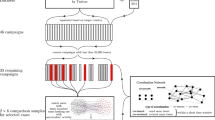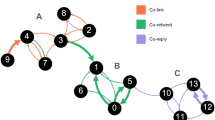Abstract
This paper covers a hybrid framework for studying coordinated social media behaviour. The study focuses on social media activity during the 2019 Philippine National and Local Elections. With the use of social media information obtained from the CrowdTangle platform, the research is able to extract necessary post detail information that can be used to determine coordinated behaviour. The study tags posts are coordinated if they have shared media content between five or more posts within a 1-minute period. This should point to a high degree of coordination. The results are then visualized using the Fruchterman–Reingold algorithm using the Networkx library to see the various clusters. This gives us a reasonable amount of data to further explore and act upon. This framework was able to extract a number of Facebook accounts that showed a high degree of coordinated behaviour. These accounts refer to media that are no longer available which is not characteristic of reputable content.
Access this chapter
Tax calculation will be finalised at checkout
Purchases are for personal use only
Similar content being viewed by others
References
Bradshaw S, Howard P (2018) Challenging truth and trust: a global inventory of organized social media manipulation. The computational propaganda project, 1
Benkler Y (2019) Cautionary notes on disinformation and the origins of distrust. Soc Sci Res Council https://doi.org/10.35650/MD.2004.d
Miniwatts Marketing Group (2020) Asia internet use, population statistics data, and facebook data—June 30 2020. Miniwatts Marketing Group. https://www.internetworldstats.com/stats3.htm
Social Weather Stations (2019) First wuarter 2019 social weather survey: 1 of 5 adult Pinoys use facebook daily as a source of news. Social Weather Stations. https://www.sws.org.ph/swsmain/artcldisppage/?artcsyscode=ART-20190629182313
Gleicher N (2020) Removing coordinated inauthentic behavior. Facebook, Menlo Park, California, United States. https://about.fb.com/news/2020/10/removing-coordinated-inauthentic-behavior-september-report/
Alvisi L , Clement A, Epasto A, Lattanzi S, Panconesi A (2013) Sok: the evolution of sybil defense via social networks . 2013 IEEE symposium on security and privacy, Berkeley, CA, 382–396. https://doi.org/10.1109/SP.2013.33
Boshmaf Y, Muslukhov I, Beznosov K, Ripeanu M (2011) The socialbot network: When bots socialize for fame and money. In: Proceedings of the 27th annual computer security applications conference, Orlando, Florida, 5–9 December, pp 93–102
CrowdTangle Team (2020) CrowdTangle. Facebook, Menlo Park, California, United States. https://apps.crowdtangle.com/admuscienceengfacebook/lists/pages
McKinney W (2010). ata structures for statistical computing in python. In: Proceedings of the 9th python in science conference (Vol 445, pp 51–56)
Hagberg AA, Schult DA, Swart PJ (2008) Exploring network structure, dynamics, and function using NetworkX. In: Varoquaux G, Vaught T, Millman J (eds) Proceedings of the 7th python in science conference (SciPy2008), (Pasadena, CA USA), pp 1–15, Aug 2008
Facebook Team (2020) A guide to sharing for webmasters. Facebook, Menlo Park, California, United States. https://developers.facebook.com/docs/sharing/webmasters/
Boyd D (2017) Hacking the attention economy. Data and Society: Points. Available at: https://points.datasociety.net/hacking-the-attention-economy-9fa1daca7a37
Giglietto F, Righetti N, Rossi L, Marino G (2020) It takes a village to manipulate the media: coordinated link sharing behavior during 2018 and 2019 Italian elections. Commun Soc Inf, pp 1–25
Author information
Authors and Affiliations
Corresponding author
Editor information
Editors and Affiliations
Rights and permissions
Copyright information
© 2022 The Author(s), under exclusive license to Springer Nature Singapore Pte Ltd.
About this paper
Cite this paper
Yu, W.E.S. (2022). A Framework for Studying Coordinated Behaviour Applied to the 2019 Philippine Midterm Elections. In: Yang, XS., Sherratt, S., Dey, N., Joshi, A. (eds) Proceedings of Sixth International Congress on Information and Communication Technology. Lecture Notes in Networks and Systems, vol 236. Springer, Singapore. https://doi.org/10.1007/978-981-16-2380-6_63
Download citation
DOI: https://doi.org/10.1007/978-981-16-2380-6_63
Published:
Publisher Name: Springer, Singapore
Print ISBN: 978-981-16-2379-0
Online ISBN: 978-981-16-2380-6
eBook Packages: Intelligent Technologies and RoboticsIntelligent Technologies and Robotics (R0)




